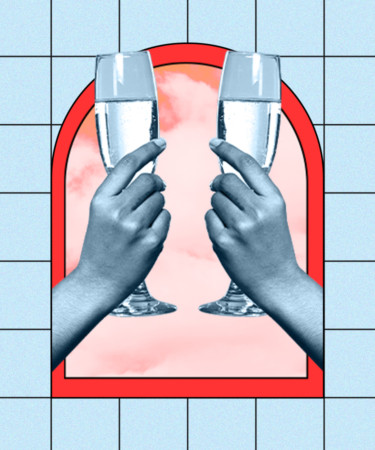At weddings, dinner parties, and celebrations of all ilks, it’s a common custom for hosts and poetic (if not tipsy) guests to raise their glasses and propose a toast. The ritual is simple: Attention is called, glasses are held high, and a sentimental speaker offers a few words of gratitude or a short, congratulatory speech. This is followed by the clinking of glasses around the room and, finally, the sipping of Champagne and other festive beverages.
Though the ritual is well practiced around the globe, its origins are relatively unknown. Why is it called a “toast”? Where did the tradition come from? And is there any actual relation between these tributes and the crusty bread we enjoy at breakfast?
The answer, like the fork that taps the glass, is multi-pronged. Even historians debate the origins of the phrase, with credit given to both the Spaniards and Brits — and for reasons spanning spoiled wine to bugs.
Some credit the first toast to the Spanish, whose tapas have an interesting correlation with drinking culture. Tapas refer in English to the snacks served at bars and translates directly as “cover” or “lid.” As the story goes, Spanish bartenders used bread slices to cover customers’ drinks to protect against dust and bugs. These drink covers are thought by some historians to have been the first edible “tapas” — a precursor to the small-plates category we know today.
Other accounts argue that the British were the first to propose a toast. Since before the days of William Shakespeare, the English dipped toasted bread into their drinks to impart some flavor or spice notes, and detract from the foul odors of bitter wines.
Another story goes that a 5th-century British seductress gave a drunken King Vortigern a large glass of spiced wine, crying out “Waes hael!” — a toast to his health. The tale later evolved into a holiday tradition for Elizabethan-era revelers during Christmastime: English carolers went door to door to wish friends and neighbors a happy new year — punch bowl in hand — and encouraged those they visited to dip toasted bread into the drink to share in the holiday merriment. The custom later evolved into the apple wassail ceremony, during which participants gather in apple orchards to throw punch-soaked pieces of bread into the orchard trees (supposedly to ward off evil spirits).
Wherever the bread-breaking custom began, the term stuck. Thankfully, these days, the “toasts” that we share need not ward off evil spirits or insects; instead it is metaphorical, meaning we can sip our wines with or without croutons. This holiday, we’ll be raising a glass to modern sanitation, winemaking practices, and crumb-less Chianti.
